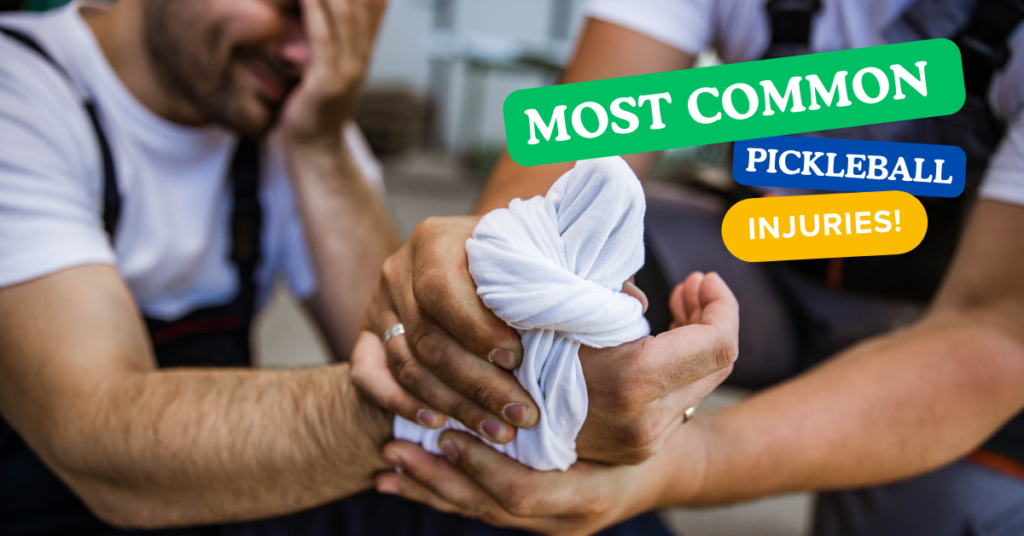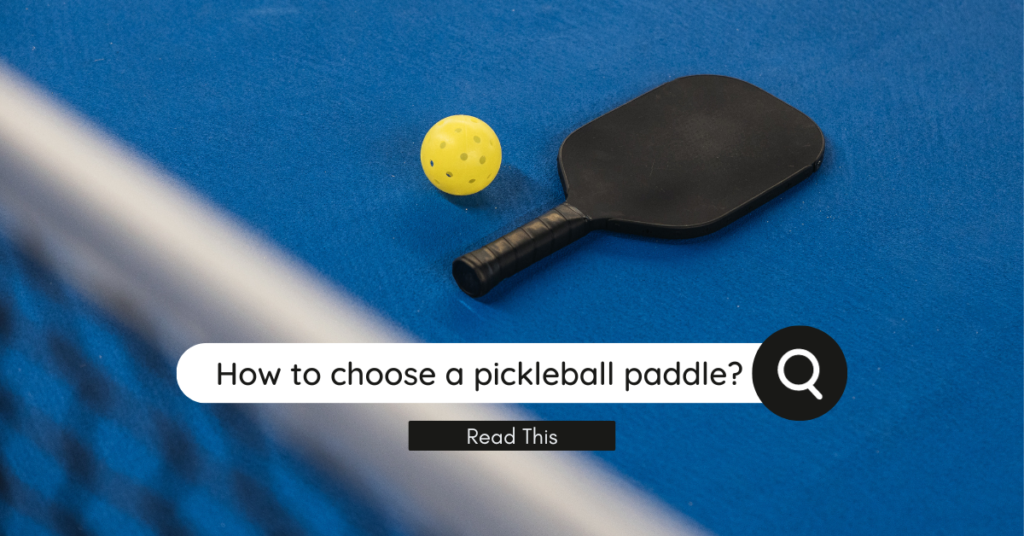Pickleball – the sport that’s as addictive as it is exhilarating. But, like any physical activity, it’s essential to be aware of the potential hiccups, especially when it comes to injuries. Whether you’re a seasoned player or just starting out, understanding the common pickleball injuries is a key part of keeping the game enjoyable and injury-free.
Join us as we delve into the world of pickleball with a safety-first mindset, ensuring you’re well-equipped to play the game you love without any unexpected setbacks. Let’s keep the rallies going and the injuries at bay!
The most common pickleball injuries include ankle sprains and shoulder pain. Pickleball is a popular sport that combines elements of tennis, badminton, and ping pong, and like any physical activity, it can lead to injuries.
Ankle sprains are common due to the quick lateral movements and changes in direction required in the sport. Shoulder pain can occur from repetitive overhead shots and serves. It is important to warm up, stretch, and use proper technique to minimize the risk of injuries in pickleball.
Understanding Pickleball Injuries
Pickleball is a fast-paced sport that combines elements of tennis, badminton, and ping pong. While it is a relatively safe sport, injuries can still occur, especially if proper precautions are not taken. Understanding the types of pickleball injuries, the risk factors involved, and the importance of preventing these injuries is crucial for players of all skill levels. In this article, we will delve into each of these aspects to give you a comprehensive understanding of pickleball injuries.
Types Of Pickleball Injuries
Like any other physical activity, pickleball comes with its fair share of injuries. Let’s take a closer look at the most common pickleball injuries:
- Strains and Sprains: Ankle sprains, wrist strains, and muscle strains are among the most frequently reported injuries in pickleball.
- Impact Injuries: Collisions with other players, falls, or accidentally hitting the ball too hard can lead to contusions, bruises, or even fractures.
- Tendonitis: Overuse of certain muscles or repetitive motions can cause tendonitis, leading to pain and inflammation.
Now that you’re aware of the types of injuries pickleball players are prone to, let’s discuss the risk factors that contribute to these injuries.
Risk Factors For Pickleball Injuries
Understanding the risk factors for pickleball injuries can help you identify potential areas of concern and take proactive measures to minimize the risk. Here are some common risk factors:
- Improper warm-up and stretching routines
- Inadequate rest and recovery time between games or practice sessions
- Excessive playing on hard surfaces, leading to increased impact on joints
- Not using appropriate protective gear, such as knee pads or ankle braces
- Ignoring proper technique and form while executing shots
Now that we’ve discussed the risk factors, let’s explore why it’s so important to take preventive measures when it comes to pickleball injuries.
Importance Of Preventing Pickleball Injuries
Preventing pickleball injuries should be a top priority for all players, regardless of skill level. By taking the necessary precautions, you can avoid potential setbacks, pain, and even long-term damage. Here are some reasons why preventing pickleball injuries is essential:
- Faster recovery time allows you to get back on the court sooner
- Reduced risk of chronic injuries that can impact your long-term health and performance
- Improved overall athletic performance and enjoyment of the game
- Lower medical costs associated with treating injuries
Now that we understand the importance of injury prevention, let’s move on to the practical steps you can take to minimize the risk of pickleball injuries in our next article.
Common Pickleball Injuries
Pickleball players often experience common injuries such as strains, sprains, and tendonitis due to the fast-paced nature of the sport. These injuries can occur in the shoulders, elbows, wrists, and ankles, requiring careful warm-ups and stretching to prevent them.
Pickleball has gained incredible popularity in recent years, attracting people of all ages and skill levels. It is a fast-paced and exciting sport that combines elements of tennis, badminton, and table tennis. However, like any physical activity, there is always the risk of injury. In this article, we will explore the most common pickleball injuries and provide tips on how to prevent them.
1. Shoulder Injuries
Shoulder injuries are one of the most common types of injuries experienced by pickleball players. The repetitive overhead motions, such as serving and smashing, can put a tremendous amount of strain on the shoulder joint. This can lead to conditions like rotator cuff tears, tendinitis, and bursitis. To prevent shoulder injuries, it is essential to warm up properly before playing. Perform dynamic shoulder stretches to increase flexibility and range of motion. Additionally, practicing proper technique and using the correct grip size can also reduce the risk of injury. Remember, if you feel any pain or discomfort in your shoulder during play, it is crucial to take a break and seek medical advice if necessary.
2. Knee Injuries
Knee injuries are another common concern among pickleball players. The rapid lateral movements and quick changes in direction can put stress on the knees, leading to conditions such as ligament sprains, tendonitis, or even meniscal tears. To protect your knees, investing in a good pair of court shoes is crucial. These shoes should provide excellent support and stability. Wearing knee braces can also offer extra protection, especially for individuals with a history of knee problems. Strengthening the muscles around the knee through targeted exercises can further reduce the risk of injury.
3. Ankle Injuries
Ankle injuries are common in sports that involve quick stops, starts, and pivoting movements, and pickleball is no exception. Rolling or spraining an ankle can cause significant pain and limit your ability to play. To prevent ankle injuries, ensure that you have proper footwear with ankle support. Strengthening the muscles around the ankle and improving balance through exercises like calf raises and single-leg balances can also help. It is also important to be aware of the playing surface and avoid uneven or slippery courts whenever possible. In conclusion, while pickleball is an incredibly fun and enjoyable sport, it is important to be aware of the potential for injuries. By taking proper precautions, including warming up, wearing the right gear, and practicing good technique, you can minimize the risk of these common pickleball injuries. Stay safe, have fun, and keep playing!
Preventing Pickleball Injuries
Discover the most common pickleball injuries and learn essential tips to prevent them. Protect yourself on the court and stay injury-free with these expert strategies.
Warm-up And Stretching
Before diving into intense pickleball gameplay, it is crucial to prioritize a warm-up and stretching routine. Warming up your body and stretching your muscles not only helps to prevent injuries but also improves your performance on the court. Here are a few recommendations for effective warm-up and stretching:
- Start with light cardiovascular exercises, such as jogging or jumping jacks, for 5-10 minutes to get your blood flowing and increase your heart rate.
- Focus on dynamic stretches that mimic the movements you’ll be making on the court, such as arm circles, leg swings, and torso twists.
- Avoid static stretching before playing, as it can decrease muscle power and increase the risk of injury.
- Save static stretches for after your pickleball session to help improve flexibility and reduce muscle soreness.
Proper Technique And Form
Another critical aspect of injury prevention in pickleball is using proper technique and form. Playing with incorrect technique not only hinders your performance but also increases the likelihood of suffering from injuries. Here are a few pointers to keep in mind:
- Learn the correct pickleball strokes and footwork from a certified instructor or through instructional videos.
- Focus on maintaining a stable and balanced stance throughout the game to avoid placing unnecessary strain on your joints.
- Engage your core muscles and use your entire body, rather than relying solely on your arm strength, to generate power in your shots.
- Avoid overexertion by gradually increasing your intensity and duration of play, allowing your body time to adapt to the demands of the game.
Protective Gear And Equipment
Although pickleball is considered a low-impact sport, it is still vital to prioritize your safety by wearing appropriate protective gear and using suitable equipment. Here are some recommendations for protecting yourself on the court:
- Invest in a good pair of pickleball-specific shoes that provide proper support, stability, and traction.
- Wear comfortable and breathable clothing that allows freedom of movement while keeping you cool and dry.
- Consider using elbow and knee pads to provide extra protection against falls and collisions.
- Use a high-quality paddle with a grip that fits your hand comfortably and reduces the risk of developing blisters.
Rest And Recovery
Lastly, allowing your body sufficient time for rest and recovery is essential for injury prevention and overall well-being. Here are a few guidelines to follow:
- Listen to your body and take regular breaks during your pickleball sessions to prevent fatigue and muscle strain.
- Ensure you get an adequate amount of sleep each night to support muscle repair and tissue regeneration.
- Incorporate rest days into your training schedule to allow your body to recover from the physical demands of the game.
- Consider incorporating recovery techniques such as foam rolling, stretching, and massages to alleviate muscle tension and promote faster healing.
Frequently Asked Questions Of Most Common Pickleball Injuries
What Are The Most Injuries From Pickleball?
The most common injuries from pickleball include sprains, strains, and tendinitis. Other common injuries are knee and ankle injuries, as well as shoulder and elbow pain. It is important to warm up, wear proper footwear, and use proper technique to prevent injuries.
Is Pickleball Hard On The Body?
Pickleball can be physically demanding but is generally not hard on the body. With its slower pace and smaller court size, it poses less risk of injury compared to other sports. However, like any physical activity, proper warm-up, technique, and conditioning can help prevent strain or injury.
What Muscles Are Injured In Pickleball
The muscles most commonly injured in pickleball are the shoulder, elbow, and knee due to repetitive movements and quick direction changes.
Is Pickle Ball Injury Prone?
Pickleball comes with some risk of injury due to its fast-paced nature, quick movements, and potential collision with players or equipment. However, with proper technique, warm-up exercises, and safety precautions, the risk can be minimized.
Faq 1: What Are The Most Common Pickleball Injuries?
The most common pickleball injuries include sprains, strains, tendonitis, and fractures due to overuse and accidents.
Faq 2: How Can I Prevent Pickleball Injuries?
To prevent pickleball injuries, warm up before playing, use proper technique, wear protective gear, maintain good physical fitness, and listen to your body.
Faq 3: What Is The Most Effective Treatment For Pickleball Injuries?
The most effective treatment for pickleball injuries usually involves rest, ice, compression, elevation, and physical therapy if necessary. Pain medication may also be recommended.
Conclusion
Pickleball players should be aware of the most common injuries that can occur while playing this popular sport. By taking precautions such as warming up, using proper technique, and wearing protective gear, players can reduce their risk of injury. It’s important to listen to your body and seek medical attention if needed.
Remember, a well-informed and prepared player can enjoy the game of pickleball for years to come. Stay safe and have fun on the court!



